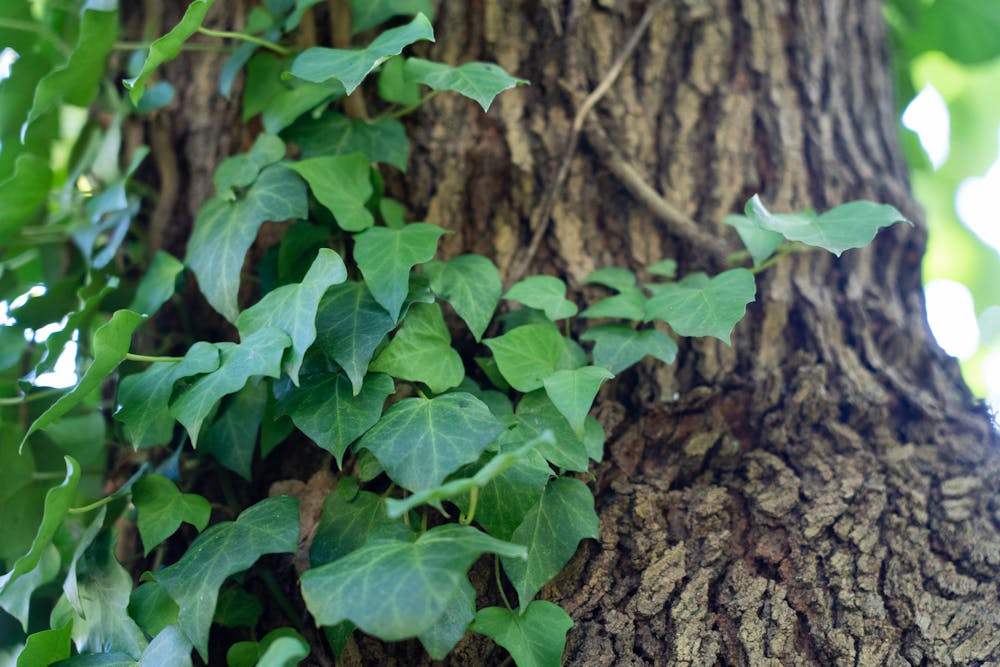From oaks and beaches to poplars and maples, D.C. has its fair share of greenery. But invasive plants threaten the city’s ecosystem.
It is hard to miss the walls of ivy walking through Battery Kemble or Glover Archbold Park. Deep green and lush in appearance, these leafy knolls and walls are captivating in their otherworldly beauty. However, these leafy fiends destroy native ecosystems.
English Ivy is an evergreen vine with palm sized, spade shaped leaves. Porcelain Berry is characterized by brightly colored berries that come in green, blue, purple and bright pink. Oriental Bittersweet has oval pointed leaves and bright red berries, which birds eat and spread.
These are just a few of the non-native, invasive species that plague D.C.
The vines can be tight enough to cut through the bark and stop nutrients from traveling through trees, killing them by strangulation. They weigh down branches and block sunlight or add so much extra weight that it causes trees to fall.
Rock Creek botanist Ana Chuquin noted that local species can be harmful in certain circumstances, and non-native plants are not always problematic, such as those used in agriculture.
“There are native species that can be weedy or act as invasive in certain locations,” Chuquin said. “One of them is Poison Ivy.”
Invasive species are a particular problem in D.C. One 2020 study from the Ecological Society of America discussing National Parks along the entire East Coast noted that parks closest to D.C. had the highest abundance of invasive species.
D.C.’s geography plays a large role in this. The city acts as a key area in the watershed, with water carrying particles like invasive species through the city.
“In general, cities are more prone to non-native invasives, because of the watershed in the case of D.C.,” Chuquin said. “Also because people have more ability to experiment with their yards, especially in D.C. because natural areas are so close to private property.”
Rock Creek Park, Glover Archbold Park, Battery Kemble and many other parks in D.C. directly border homes. As invasive species are introduced for private landscaping purposes, this proximity leads to the non-native invasive species spreading to the treelines.
Over the last few decades, there have been many different efforts to stop their spread, or at least limit the harm they cause to trees.
Weed Warriors is a volunteer program created to train volunteers in removing invasive species. Chuquin oversees the Weed Warriors in Rock Creek Park, educating the local community.
“Natural research specialists saw the need to first and foremost protect the park, protect the trees, and saw the threat of the invasive species,” Chuquin said. “They saw that a great opportunity to mitigate that threat would be to involve the public in the removal of non-native invasive species.”
Eradicating invasive species would be very difficult, if not impossible, even for the Weed Warriors. The problem is the fact that most of these species spread fast. Even if Weed Warriors clear one place of a certain invasive species, the plant will not take long to reclaim the area if it is prevalent nearby.
This is why the program focuses on species that have come to the city recently. By specifically targeting groups of newer invasive species, the Weed Warriors can create bigger impacts, stopping the spread of a non-native species early and hopefully for good. They call this approach “early detection and rapid response.”
“From our perspective, it is very important to remove that specific group because by doing that we’re going to save a lot of money or a lot of resources,” said Chuquin.
This year they are focused on removing fountain grass and wavyleaf basket grass.
Climate change has the potential to greatly worsen the invasive species issue in D.C. Most invasive vines are highly versatile and better at adapting to change than local species, which means they will not experience the same struggle with rising temperatures and more severe weather that local plants might.
One study from 2022 found that the number of invasive species in the world has been increasing exponentially. This can even be seen in D.C.
“I see it in a lot of landscaping places and people’s yards,” said Marie Remey, a freshman in the College of Arts and Sciences, about the English Ivy in D.C. “It's just really hard to get rid of, I mean I see it everywhere now.”
The Weed Warriors program works by saving small chunks of a park at a time, creating feasible goals that give volunteers a sense of accomplishment and typically keep them coming back.
“That brings a lot of happiness for people,” Chuquin said. “We’re extremely grateful for all the time invested in the park and for the commitment that some people have.”
Correction: A previous version of this story incorrectly stated that Chuquin ran the entire Weed Warriors organization. It has been updated to reflect that Chuquin oversees the Rock Creek Park chapter.
This article was edited by Soumya Sahay, Patricia McGee and Abigail Pritchard. Copy editing done by Isabelle Kravis and Charlie Mennuti.





